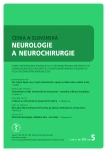Motor Stereotypies in Childhood – Case Reports
Authors:
I. Příhodová; L. Koumarová; S. Nevšímalová; E. Růžička
Authors place of work:
Neurologická klinika a Centrum klinických neurověd, 1. LF UK a VFN v Praze
Published in the journal:
Cesk Slov Neurol N 2012; 75/108(5): 621-625
Category:
Kazuistika
Summary
Motor stereotypies are involuntary purposeless coordinated movements manifesting in a certain fixed pattern. Stereotypic movements classified as secondary, pathological stereotypies are common in children with neurodevelopmental disorders (autism, mental retardation, Rett syndrome) and sensory impairment. Motor stereotypies can also appear in many typically developing children (primary, physiological stereotypies). Primary stereotypies usually begin before three years of age. According to the type of movement they are categorized into three subgroups – common stereotypies, head nodding and complex stereotypies. Differential diagnosis involves tics, epileptic automatisms, paroxysmal dyskinesias and in the case of head nodding also structural brain lesions, Sandifer syndrome or spasmus nutans. Motor stereotypies are benign movements but they can persist into adulthood. Comorbidities with attention deficit hyperactivity disorder, tics and other psychiatric disorders (anxiety, obsessive – compulsive disorder) have been described. We present case reports with various types of primary stereotypies (including videorecordings) and an overview of differential diagnostics and literature.
Key words:
primary motor stereotypies – common stereotypies – head
nodding – complex stereotypies – secondary motor stereotypies – complex
tics
Zdroje
1. Jankovic J. Stereotypies. In: Marsden CD, Fahn S (eds). Movement disorders. 3rd ed. London: Butterworth Heinemann 1994: 501−517.
2. American Psychiatric Association. Diagnostic and Statistical Manual of Mental Disorders – Text Revision, DSM-IV TR. 4th revised ed. Washington DC: American Psychiatric Association 2000.
3. Muthugovindan D, Singer H. Motor stereotypy disorders. Curr Opin Neurol 2009; 22(2): 131−136.
4. Singer HS. Motor stereotypies. Semin Pediatr Neurol 2009; 16(2): 77−81.
5. Mezinárodní klasifikace nemocí, 10. revize. Duševní poruchy a poruchy chování. Popisy klinických příznaků a diagnostická vodítka. Praha: Psychiatrické centrum 1992.
6. Troster H. Prevalence and functions of stereotyped behaviours in nonhandicapped children in residential care. J Abnorm Child Psychol 1994; 22(1): 79−97.
7. Foster LG. Nervous habits and stereotyped behaviors in preschool children. J Am Acad Child Adolesc Psychiatry 1998; 37(7): 711−717.
8. MacDonald R, Green G, Mansfield R. Stereotypy in young children with autism and typically developing children. Res Dev Disabil 2007; 28(3): 266−277.
9. Harris K, Mahone EM, Singer H. Nonautistic motor stereotypies: clinical features and longitudinal follow-up. Pediatr Neurol 2008; 38(4): 267−272
10. Mahone EM, Bridges D, Prahme C, Singer HS. Repetitive arm and hand movements (complex motor stereotypies) in children. J Pediatr 2004; 145(3): 391−395.
11. Castellanos FX, Ritchie GF, Marsh WL, Rapoport JL. DSM-IV stereotypic movement disorder: persistence of stereotypies of infancy in intelectually normal adolescents and adults. J Clin Psychiatry 1996; 57(3): 116−122.
12. Berkson G, Rafaeli-Mor N, Tarnovsky S. Body-rocking and other habits of college students and persons with mental retardation. Am J Ment Petard 1999; 104(2): 107−116.
13. Niehaus DJ, Emsley RA, Brink P, Stein DJ. Stereotypies: prevalence and association with compulsive and impulsive symptoms in college students. Psychopathology 2000; 33(1): 31−35.
14. Hottinger-Blanc PM, Ziegler AL, Deonna T. A special type of head stereotypies in children with developmental (cerebellar) disorder: description of 8 cases and literature review. Eur J Paediatr Neurol 2002; 6(3):143−152.
15. Ošlejšková H. Neepileptické záchvaty imitující epileptické v dětství a adolescenci. Neurol Prax 2010; 11(3): 146–152.
16. Hadač J. Diferenciální diagnostika neepileptických záchvatů u dětí. Pediatr pro Praxi 2006; 1: 31–34
17. Muchová M. Diferenciální diagnostika abnormního držení hlavy v dětském věku. Neurol Prax 2009; 10(1): 39–43.
18. Hořínek D, Schwab J, Tichý M, Kyncl M, Šanda J, Paulas L et al. Neuroendoskopická léčba syndromu kývavé panenky u suprasellárních cyst. Cesk Slov Neurol N 2007; 70/103(1): 88–93.
19. Bonnet C. Developmental and benign movement disorders in childhood. Mov Dis 2010; 25(10): 1317−1333.
20. Růžička E, Jankovic J. Tiky a Touretteův syndrom. In: Růžička E (ed). Dyskinetické syndromy a onemocnění. Praha: Galén 2002: 167−197.
21. Singer HS. Motor stereotypias. In: Singer HS, Mink JW, Gilbert DL, Jankovic J (eds). Movement disorders in childhood. Philadelphia: Saunders Elsevier 2010: 56–65.
22. Dickson PR, Lang CG, Hinton SC, Kelley AE. Oral stereotypy induced by amphetamine microinjection into striatum:an anatomical mapping study. Neuroscience 1994; 61(1): 81–91.
23. Kates WR, Lanham DC, Singer HS. Frontal white matter reductions in healthy males with complex stereotypies. Pediatr Neurol 2005; 32(2): 109−112.
24. Rapp JT, Vollmer TR. Stereotypy II: a review of neurobiological interpretations and suggestions for an integration with behavioural methods. Res Dev Disabil 2005; 26(6): 548−564.
Štítky
Dětská neurologie Neurochirurgie NeurologieČlánek vyšel v časopise
Česká a slovenská neurologie a neurochirurgie

2012 Číslo 5
- Metamizol jako analgetikum první volby: kdy, pro koho, jak a proč?
- MUDr. Lenka Klimešová: Multioborová vizita může být klíčem k efektivnější perioperační léčbě chronické bolesti
- Realita léčby bolesti v paliativní péči v Německu
Nejčtenější v tomto čísle
- Motorické stereotypie v dětském věku – kazuistiky
- Emoční paměť – patofyziologie a klinické souvislosti
- Neurologické komplikace spojené s asistovanou reprodukcí – kazuistika
- Likvorový triplet (tau proteiny a beta-amyloid) v diagnostice Alzheimerovy-Fischerovy nemoci
